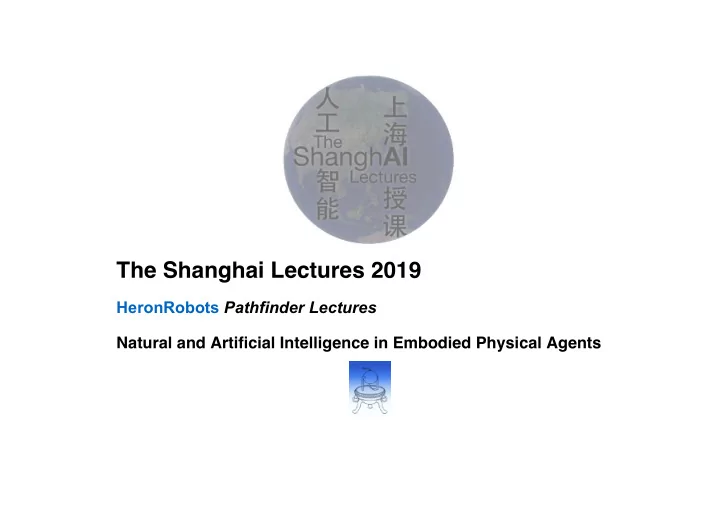

The Shanghai Lectures 2019 HeronRobots Pathfinder Lectures Natural and Artificial Intelligence in Embodied Physical Agents
欢迎您参与 The ShanghAI Lectures An experiment in global teaching Fabio Bonsignorio • The ShanghAI Lectures and Heron Robots • “ 来⾃臫上海渚的⼈亻⼯左智能系列劣讲座 ”
Lecture 5. ML, DL ..Object Recognition an Embodied AI view Fabio Bonsignorio The ShanghAI Lectures and Heron Robots
Crash Introduction to ML Lecture slides adapted from Deep Learning www.deeplearningbook.org Ian Goodfellow 2016-09-26
Representations Matters Figure 1.1
Depth: Repeated Composition Figure 1.2
Computational Graphs Figure 1.3
Machine Learning and AI Figure 1.4
Historical Waves Figure 1.7
Historical Trends: Growing Datasets Figure 1.8
The MNIST Dataset Figure 1.9
Connections per Neuron Figure 1.10
Number of Neurons Figure 1.11
Solving Object Recognition Figure 1.12
Numerical Computation for Deep Learning
Numerical concerns for implementations of deep learning algorithms Algorithms are often specified in terms of real numbers; real numbers cannot be implemented in • a finite computer Does the algorithm still work when implemented with a finite number of bits? • Do small changes in the input to a function cause large changes to an output? • Rounding errors, noise, measurement errors can cause large changes • Iterative search for best input is difficult •
Roadmap Iterative Optimization • Rounding error, underflow, overflow •
Iterative Optimization Gradient descent • Curvature • Constrained optimization •
Gradient Descent Figure 4.1
Approximate Optimization Figure 4.3
We usually don’t even reach a local minimum
Iterative Optimization Gradient descent • Curvature • Constrained optimization •
Critical Points Figure 4.2
Saddle Points Figure 4.5 (Gradient descent escapes, Saddle points attract see Appendix C of “Qualitatively Newton’s method Characterizing Neural Network Optimization Problems”)
Curvature Figure 4.4
Neural net visualization At end of learning: - gradient is still large - curvature is huge (From “Qualitatively Characterizing Neural Network Optimization Problems”)
Iterative Optimization Gradient descent • Curvature • Constrained optimization •
Roadmap Iterative Optimization • Rounding error, underflow, overflow •
Numerical Precision: A deep learning super skill Often deep learning algorithms “sort of work” • Loss goes down, accuracy gets within a few • percentage points of state-of-the-art No “bugs” per se • Often deep learning algorithms “explode” (NaNs, large • values) Culprit is often loss of numerical precision •
Rounding and truncation errors In a digital computer, we use float32 or • similar schemes to represent real numbers A real number x is rounded to x + delta for • some small delta Overflow: large x replaced by inf • Underflow: small x replaced by 0 •
Bug hunting strategies If you increase your learning rate and the loss gets • stuck , you are probably rounding your gradient to zero somewhere: maybe computing cross-entropy using probabilities instead of logits For correctly implemented loss, too high of learning • rate should usually cause explosion
Machine Learning Basics
Linear Regression Figure 5.1
Underfitting and Overfitting in Polynomial Estimation Figure 5.2
Generalization and Capacity Figure 5.3
Training Set Size Figure 5.4
Weight Decay Figure 5.5
Bias and Variance Figure 5.6
Decision Trees Figure 5.7
Principal Components Analysis Figure 5.8
Curse of Dimensionality Figure 5.9
Nearest Neighbor Figure 5.10
Manifold Learning Figure 5.11
Convolutional Networks
Convolutional Networks • Scale up neural networks to process very large images / video sequences • Sparse connections • Parameter sharing • Automatically generalize across spatial translations of inputs • Applicable to any input that is laid out on a grid (1-D, 2-D, 3-D, …)
Key Idea Replace matrix multiplication in neural nets • with convolution Everything else stays the same • Maximum likelihood • Back-propagation • etc. •
Matrix (Dot) Product m = m • n p p n Must match
Edge Detection by Convolution Input Output -1 -1 Kernel Figure 9.6
Practical Methodology
What drives success in ML?
Example: Street View Address Number Transcription
Three Step Process
Identify Needs
Choose Metrics
End-to-end System
Deep or Not?
Choosing Architecture Family
Increasing Depth
High Test Error
Increasing Training Set Size
Tuning the Learning Rate Figure 11.1
Monte Carlo Methods
Roadmap Basics of Monte Carlo methods • Importance Sampling • Markov Chains •
Randomized Algorithms Las Vegas Monte Carlo Random amount of Type of Answer Exact error Chosen by user (longer Random (until answer runtime gives lesss Runtime found) error)
Estimating sums / integrals with samples
Justification Unbiased: • The expected value for finite n is equal to the correct value • The value for any specific n samples will have random error, but the • errors for different sample sets cancel out Low variance: • Variance is O (1/ n ) • For very large n , the error converges “almost surely” to 0 •
For more information…
Object Categorization Lecture slides adapted from "Object Categorization an Overview and Two Models” Fei Fei Li
materia perceptible vision l thing
Plato said… Ordinary objects are classified together if they `participate' in the same abstract Form, such as the Form of a Human or the Form of Quartz. Forms are proper subjects of philosophical investigation, for they have the highest degree of reality. Ordinary objects, such as humans, trees, and stones, have a lower degree of reality than the Forms. Fictions, shadows, and the like have a still lower degree of reality than ordinary objects and so are not proper subjects of philosophical enquiry.
How many object categories are there?
Identification: is that Potala Palace? Verification: is that a lamp? Detection: are there people?
mountain tree building
Three main issues Representation How to represent an object category Learning How to form the classifier, given training data Recognition How the classifier is to be used on novel data
“Bag-of-words” models
Hints that DL … MUST WORK Rethinking Robotics for the Robot Companion of the future Rethinking Robotics for the Robot Companion of the future Rethinking Robotics for the Robot Companion of the future
Thank you! fabio.bonsignorio@gmail.com fabio.bonsignorio@heronrobots.com www.shanghailectures.org
The Shanghai Lectures 2020 HeronRobots Path-finder Lectures Natural and Artificial Intelligence in Embodied Physical Agents
Recommend
More recommend